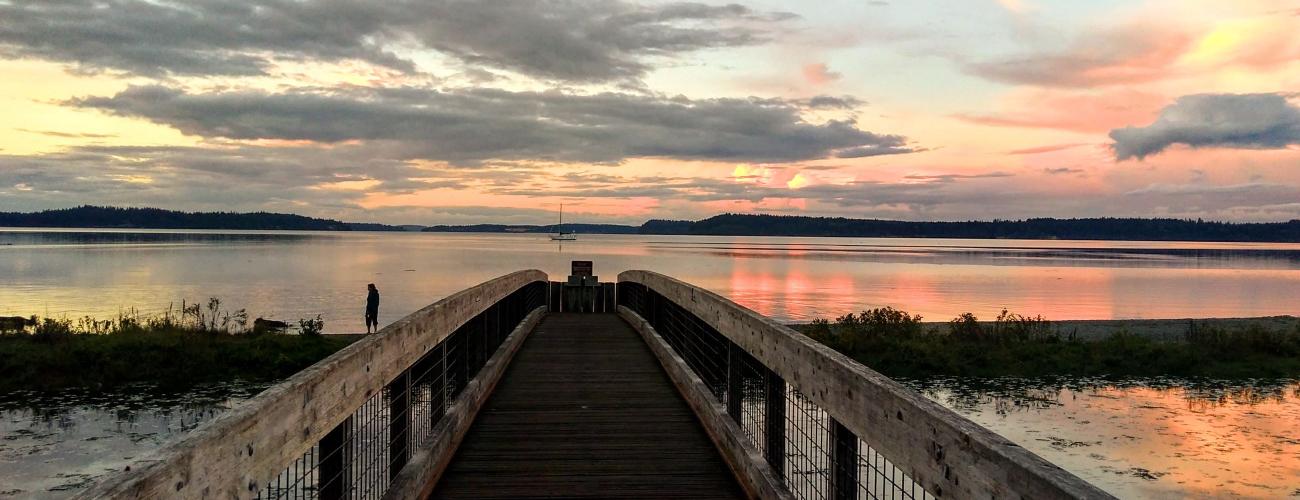Tolmie State Park History
Tolmie State Park provides access to the shores and undersea gardens of southern Puget Sound. The winding saltwater passageways of the South Sound, including Nisqually Reach in front of the park, were molded and scoured by glacial meltwaters at the close of the Pleistocene ice age.
Indigenous Lands
Tolmie State Park lies within the traditional territories of Coast Salish Indigenous people whose present-day descendants include members of the Nisqually Indian Tribe and Squaxin Island Tribe. For thousands of years the shoreline, pocket estuary and wooded bluffs have provided habitat for a diverse community of life that forms the basis of their cultures. Local tribes ceded ownership of the area to the US federal government under duress in the Treaty of Medicine Creek in 1854.
Government land surveys were completed in 1854. The land in today’s Tolmie State Park passed into private ownership as Cash Entry Patents, a form of land sales from the public domain. The waterfront areas of today’s park were purchased by Thomas M. Reed in 1871, who was at the time employed as the Chief Clerk of the Surveyor General of Washington Territory, Elisha P. Ferry. After statehood in 1889, Reed was elected as the first Washington State Auditor (Ferry was elected as the first Governor of Washington). The forested area now traversed by the Four Cedars Trail was purchased by Clarence B. Bagley, also an employee in the Surveyor General’s office, in 1872. Bagley later pursued a career as a newspaper publisher, and helped found the Washington State Historical Society in 1891.
The land was purchased by Charles and Ola Jones in 1936. They made their home there and also built cabins that they rented to beach visitors.
Saving the Beach for People and Salmon
Negotiations to establish a state park at “Jones Beach” were initiated in 1961, and lands making up today’s park were acquired by the Washington State Parks and Recreation Commission (WSPRC) from the Joneses by 1965. On May 25, 1972, Commissioner of Public Lands Bert Cole withdrew 27 acres of the bed of Puget Sound adjacent to the park lands to be managed as an underwater park. The underwater park includes three barges sunk in 1965, marked by a buoy over 1,000’ from shore. Divers reaching them can find nudibranchs, sea pens, sea stars, plumose (Metridium spp.) and swimming (Stomphia coccinea) anemones, crabs, striped sea perch, octopus and wolf eels.
The WSPRC received a grant of over $170,000 from the federal Bureau of Outdoor Recreation in 1972 to build park facilities for visitors, but park planners discovered that the park's shoreline was being damaged by riprap placed on adjoining sections of shoreline, disrupting the natural flow of sediments to replenish the beach. Conservationist Wolf Bauer was contacted to propose a solution to the problem, and he designed the installation of a properly graded gravel berm beach with a backshore of stabilizing dune grass. The work was completed in 1974, one of the first beach nourishment projects to restore a Puget Sound beach. Day-use facilities were developed, and the park was dedicated for public use on June 20, 1975.
The park was named in honor of Dr. William Fraser Tolmie (1812-1886), a surgeon, fur trader, and scientist who commanded the Hudson Bay Company’s Fort Nisqually from 1843 to 1859. The post was located five miles across the waters of Nisqually Reach from today’s state park. Tolmie was regarded as a capable leader who viewed local Indigenous people as crucial business partners. He played an important role in easing tensions between local Indigenous people and newcomers from the United States after colonial administration of the area passed from British control to the United States in 1846. Tolmie also engaged in the scientific study of the native plants of the Pacific Northwest. Among others, the common Youth-on-Age flower (Tolmiea menziesii), found throughout today's park, was named in recognition of his botanical contributions.
The epicenter of the 2001 Nisqually Earthquake was located about 3 miles from Tolmie State Park. All sewer and water lines in the area were severely damaged, causing the temporary shutdown of the entire park. Bridges, trails and a kitchen shelter were damaged by “lateral spreading,” or cracks in the ground surface caused by the shaking.
In 2023, a $1.1 million fish passage improvement project was completed at Tolmie State Park. A 5-foot culvert was replaced with a 95-foot span bridge over the creek that feeds the tidal lagoon at the heart of the park, providing rearing and feeding habitat for salmon, as well as improving accessibility to park features.
Sharing the histories of Washington’s state parks is an ongoing project. Learn more here.

